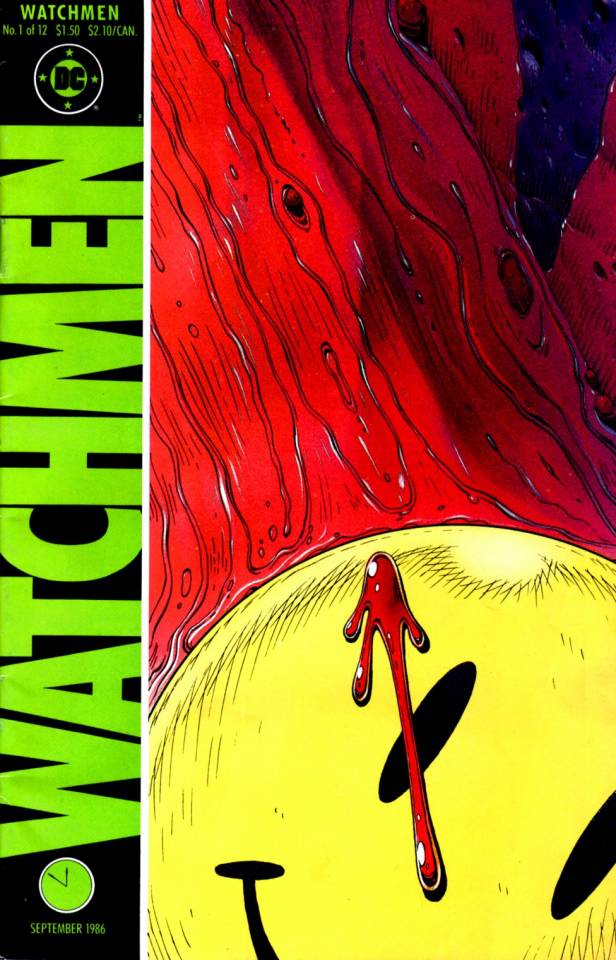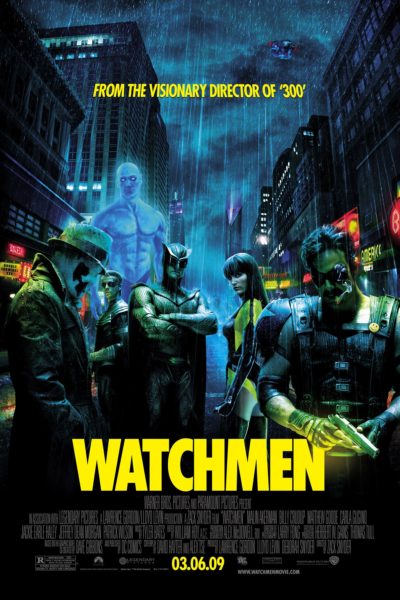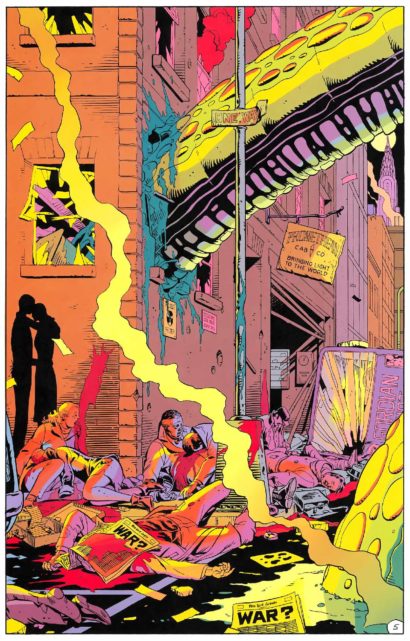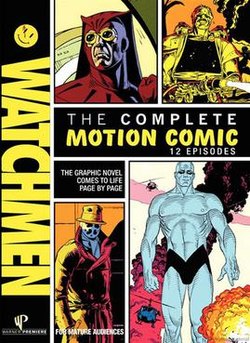 On the first week of March 2009, a pop culture phenomenon swept the U.S. that for once actually had some worth. It was the movie adaptation of Alan Moore and Dave Gibbon’s legendary WATCHMEN, a twelve issue DC miniseries from 1986-87 that became the world’s first graphic novel (although Moore has always maintained the term comic) and has remained in print ever since. Along with Frank Miller’s THE DARK KNIGHT RETURNS, Art Spiegelman’s MAUS and J.M. DeMattais and Jon J. Muth’s MOONCHILD, it was a—or even the—seminal work of the mid-1980s comics revolution that changed the field forever.
On the first week of March 2009, a pop culture phenomenon swept the U.S. that for once actually had some worth. It was the movie adaptation of Alan Moore and Dave Gibbon’s legendary WATCHMEN, a twelve issue DC miniseries from 1986-87 that became the world’s first graphic novel (although Moore has always maintained the term comic) and has remained in print ever since. Along with Frank Miller’s THE DARK KNIGHT RETURNS, Art Spiegelman’s MAUS and J.M. DeMattais and Jon J. Muth’s MOONCHILD, it was a—or even the—seminal work of the mid-1980s comics revolution that changed the field forever.
…the world’s first graphic novel …
I’m among the book’s rabid fans, having discovered it back in 1987 or ’88. I’ll spare you the details of that discovery (unlike seemingly all other WATCHMEN articles, which insist on rehashing the boring minutia of how their respective writers became WATCH-nerds) other than to say that I was immediately taken with it, and still am all these years later.
Rereading it for the hundredth or so time before seeing the movie—more on that subject in a minute—I was struck by just how strong and impacting it remains. WATCHMEN was considered the height of innovation upon its first appearance, an unapologetically adult-oriented superhero saga with all the intelligence and complexity of a good novel; those last two points are no longer especially surprising or unexpected (due in part to subsequent, nearly-as-brilliant Moore sagas like FROM HELL), but WATCHMEN holds up uniquely well in all aspects.
It begins with one of the most daring and iconic sequences in comic history: the stunningly cinematic pullback from a splash of blood to the top of a big city high rise. And the rest of the series doesn’t disappoint, being exciting, touching and uncompromisingly dark. Whereas Moore’s earlier comic epic V FOR VENDETTA was confusing and frequently hard to follow, WATCHMEN is smooth and streamlined despite the fact that it contains around a dozen central characters, numerous subplots and innumerable flashbacks.
The subject is ageing and/or screwed-up superheroes. WATCHMEN apparently began life with existing characters owned by DC Comics, but managing editor Dick Giorando had other ideas, so Moore and Gibbons ended up creating their own stable of supermen. Among the many unforgettable personages that emerged were the shady Rorschach, the borderline-evil Comedian, the radioactive Dr. Manhattan and Ozymandias, the world’s smartest man. All are caught up in an alternate universe where Richard Nixon is still president in the year 1985 and someone appears to be killing off costumed heroes. The specter of imminent nuclear war overshadows everything, making for a tense, doom-laden atm osphere.
osphere.
Dave Gibbons’ artwork fully matches Allan Moore’s conceptual genius, with a gamut of finely detailed, boldly colored (by John Higgins) panels. The angles and movement within the frames are cinema-worthy. So too the lighting, which has a tendency to impressionistically change hues within scenes.
Now onto the movie.
To my surprise, I liked Zack Snyder’s filming of WATCHMEN a fair amount. I was primed to be hyper-critical regarding Snyder’s fidelity to his source material, as I’m sure most WATCHMEN fans are. In a way I feel sorry for Snyder, as his film has an awful lot to live up to.
While I’ve never believed WATCHMEN is “unfilmable” (as some have claimed), I do acknowledge that Moore and Gibbons have set the bar impossibly high for any prospective adaptor (Terry Gilliam, Paul Greengrass and Darren Aronofsky have all taken cracks at it over the years). If nothing else, in trying to live up to the graphic novel Snyder has created one of the decade’s most daring and ambitious movies—you certainly won’t find too many others that deal seriously with quantum physics, nuclear Armageddon and the nature of godhood, and with settings that include New York City, Antarctica and the canyons of Mars. If the comic didn’t exist I fully believe those critics who panned the film would have instead dubbed it a flawed masterpiece.
The flick certainly isn’t without problems, an inevitability when compressing a twelve-issue comic into a 2½-hour framework. Snyder is obviously most comfortable orchestrating action and violence, but he still pays due attention to the characters and their interrelationships—well, most of them. Ozymandias gets short shift, reduced from the morally complex figure of the comic to an effeminate two-dimensional bad guy, while the characters of  Hollis (a.k.a. Nite Owl 1) and Sally Jupiter (pity actress Carla Gugino, who’s nearly buried under poofy wigs and caked-on old age make-up) are all-but subsumed, as is the latter’s decidedly complicated relationship with the Comedian. To be fair, those things might be addressed on the DVD, which is supposed to run much longer than the theatrical release, but the new ending? Goddammit, I LOVED the squid (if you’ve read the novel you know what I’m referring to) and was damned annoyed it doesn’t turn up in this otherwise scrupulously faithful adaptation.
Hollis (a.k.a. Nite Owl 1) and Sally Jupiter (pity actress Carla Gugino, who’s nearly buried under poofy wigs and caked-on old age make-up) are all-but subsumed, as is the latter’s decidedly complicated relationship with the Comedian. To be fair, those things might be addressed on the DVD, which is supposed to run much longer than the theatrical release, but the new ending? Goddammit, I LOVED the squid (if you’ve read the novel you know what I’m referring to) and was damned annoyed it doesn’t turn up in this otherwise scrupulously faithful adaptation.
But Snyder does get quite a few things right. He knows how to set a scene with focus and economy, and without a lot of extraneous set-ups. I was certain he’d wimp out in depicting the comic’s “mature” elements, but he definitely hasn’t—if anything Snyder has actually surpassed Moore and Gibbons in the sex and violence department. His use of music is also impressive, from Simon and Garfunkle’s “Sounds of Silence” played over the funeral sequence to the drops from Philip Glass’ KOYANISQAATSI score that accompany Dr. Manhattan’s inception (although the inclusion of “Ride of the Valkyries” during the Vietnam scenes, in an apparent nod to APOCALYPSE NOW, is a bit much).
There are even some performances to savor, notably those of Billy Crudup, who strikes just the right note of detached solemnity as Dr. Manhattan, and Jackie Earle Haley, who’s simply pitch-perfect as Rorschach–so is the representation of his ever-shifting facial mask, surely one of the more visually compelling superhero movie accessories on record. It’s just too bad, though, that the film never bothers to fill us in on where Rorschach got that that mask (guess we’ll have to wait for the DVD for that, too).
In summation, WATCHMEN the movie is a good one that at times verges on greatness. I know I’ll be seeing it again, so yeah, you can consider me satisfied.
Now I’ll examine the other WATCHMEN movie, which turned up on DVD earlier this week. It’s actually a “motion comic,” with every word and image  from the original graphic novel painstakingly reproduced for the screen with semi-animated movement, music and voice-over dialogue. Lasting 5½ hours, it’s not for the casual viewer, and nor should it be taken as a substitute for the real thing. But for those familiar with the graphic novel it’s a fascinating piece of work.
from the original graphic novel painstakingly reproduced for the screen with semi-animated movement, music and voice-over dialogue. Lasting 5½ hours, it’s not for the casual viewer, and nor should it be taken as a substitute for the real thing. But for those familiar with the graphic novel it’s a fascinating piece of work.
There exist other motion comics (such as the H.P. Lovecraft-inspired DREAM-QUEST OF UNKNOWN KADATH), but this is easily the most accomplished I’ve seen. Its fidelity to the source material and range of movement are unparalleled for the form. We’re given mobile depictions of what were intended as still pictures, an altogether novel and interesting take on the brilliance that is WATCHMEN that also has the effect of inadvertently pointing out mistakes in proportion and perspective (meaning it will be especially valuable for art students).
My only problems with the motion comic version of WATCHMEN are: 1). a single guy does all the voices (even the women’s) for reasons I can’t fathom (Warner couldn’t afford to hire anyone else?), and 2). it’s missing the textual interims of the original. These are brief snippets from imaginary books, psychiatric reports, interviews and articles that come attached to the end of each chapter, and serve to enrich the characters and their universe. I realize there probably exists no satisfying way to transfer the above to motion comic form, but their absence leaves a definite void.
Oh, well. At least WATCHMEN will always exist in its original and intended form, in which guise I’ve known it for the past twenty years. I’ve long realized the time will come when, like a doting father, I’ll have to allow this beloved artifact out into the wider world. The good news is, now that the inevitable has finally occurred I can honestly say I’m largely satisfied with the roads WATCHMEN has taken.
